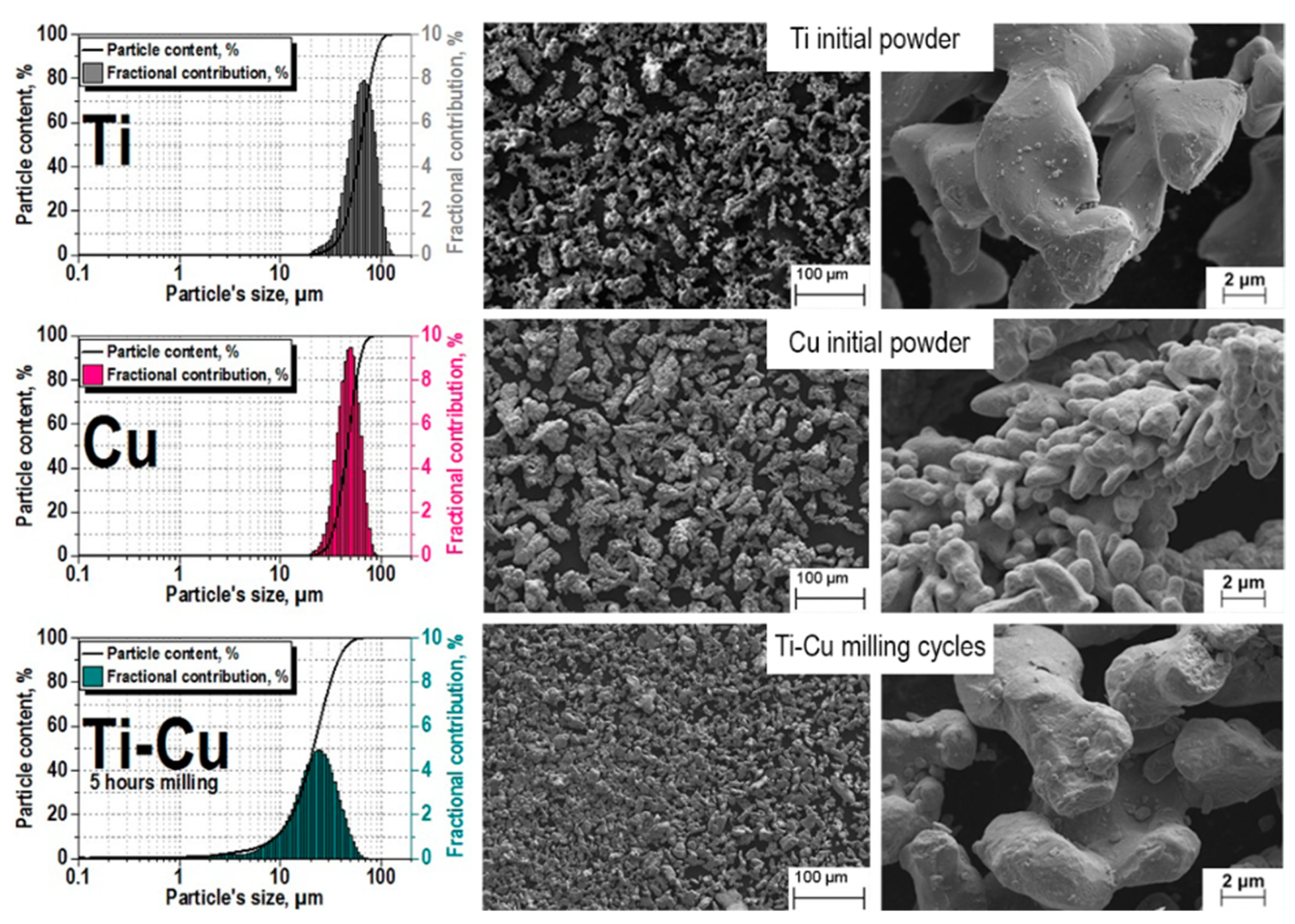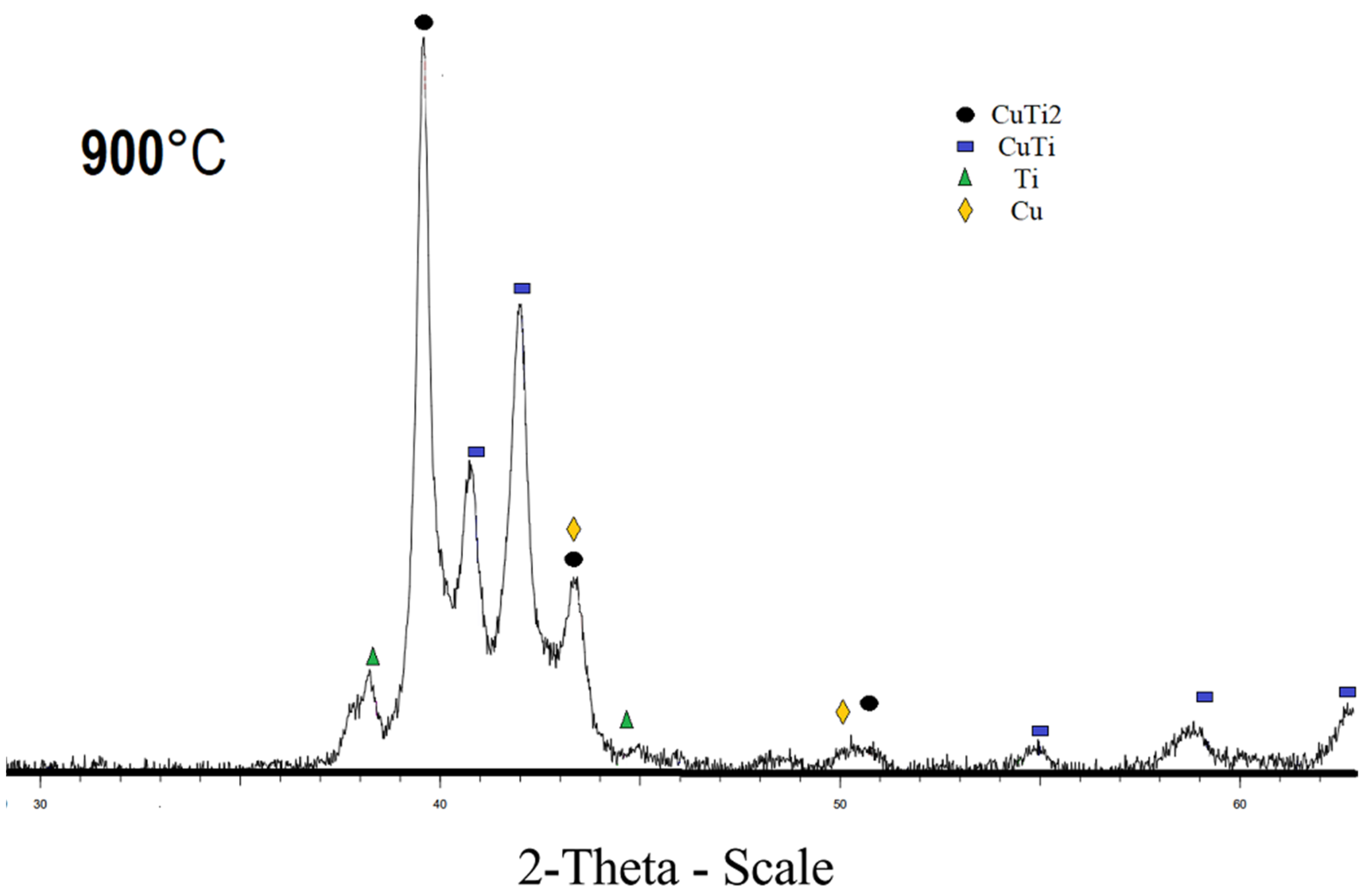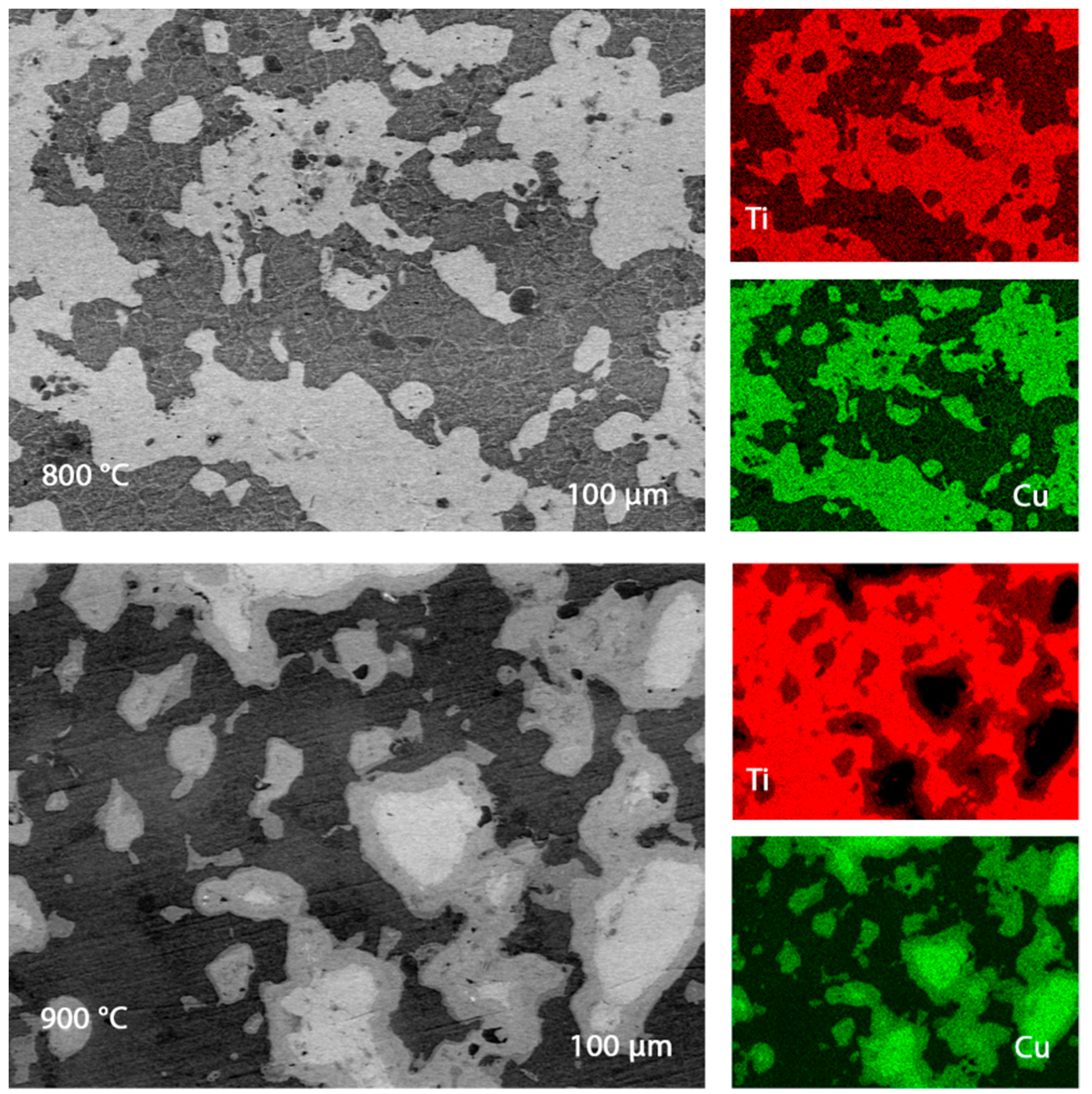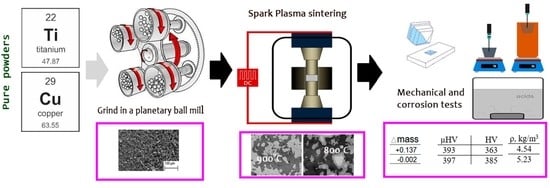Synthesis of Ti-Cu Multiphase Alloy by Spark Plasma Sintering: Mechanical and Corrosion Properties
Abstract
:1. Introduction
2. Materials and Methods
2.1. Materials
2.2. Powder Prepare
2.3. Powder Sintering
Characterization of Analytical and Physical Methods
3. Results and Discussion
3.1. Preparation of Starter Mixtures
3.2. Synthesis of Alloys of the Ti-Cu System
3.3. Physical and Mechanical Properties of Samples
3.4. Corrosion Resistance of Material
4. Conclusions
- Spark plasma sintering helps to obtain samples with high hardness for non-ferrous alloys (≈395 HV), low density, and resistance to acids.
- As the temperature of spark plasma sintering increases, the phase composition changes and the mechanical properties increase, and compaction can be associated both with specific phases and with an increase in pressure from thermal expansion.
- The presence of phase Cu4Ti3 in the sample sintered at 800 °C does not provide high corrosion protection, so phase B is preferable for a material used in an aggressive environment.
Author Contributions
Funding
Institutional Review Board Statement
Informed Consent Statement
Data Availability Statement
Conflicts of Interest
References
- Shichalin, O.O.; Buravlev, I.Y.; Papynovm, E.K.; Golub, A.V.; Belov, A.A.; Buravlev, A.A.; Sakhnevich, V.N.; Dvornikc, M.I.; Vlasovac, N.M.; Gerasimenko, A.V.; et al. Comparative study of WC-based hard alloys fabrication via spark plasma sintering using Co, Fe, Ni, Cr, and Ti binders. Int. J. Refract. Met. Hard Mater. 2022, 102, 105725. [Google Scholar] [CrossRef]
- Alagha, A.N.; Hussain, S.; Zaki, W. Additive manufacturing of shape memory alloys: A review with emphasis on powder bed systems. Mater. Des. 2021, 204, 109654. [Google Scholar] [CrossRef]
- Xiang, T.; Chen, D.; Lv, Z.; Yang, Z.; Yang, L.; Li, C. Robust superhydrophobic coating with superior corrosion resistance. J. Alloys Compd. 2019, 798, 320–325. [Google Scholar] [CrossRef]
- Conti, S.; Neilson, D.; Peeters, F.M.; Perali, A. Transition metal dichalcogenides as strategy for high temperature electron-hole superfluidity. Condens. Matter 2020, 5, 22. [Google Scholar] [CrossRef] [Green Version]
- Zhou, S.; Zhao, Y.; Wang, X.; Li, W.; Chen, D.; Sercombe, T.B. Enhanced corrosion resistance of Ti-5 wt.% TiN composite compared to commercial pure Ti produced by selective laser melting in HCl solution. J. Alloys Compd. 2020, 820, 153422. [Google Scholar] [CrossRef]
- Lopes, C.; Gabor, C.; Cristea, D.; Costa, R.; Domingues, R.P.; Rodrigues, M.S.; Borges, J.; Alves, E.; Barradas, N.P.; Munteanu, D.; et al. Evolution of the mechanical properties of Ti-based intermetallic thin films doped with different metals to be used as biomedical devices. Appl. Surf. Sci. 2020, 505, 144617. [Google Scholar] [CrossRef]
- Rößner, L.; Armbrüster, M. Electrochemical Energy Conversion on Intermetallic Compounds: A Review. ACS Catal. 2019, 9, 2018–2062. [Google Scholar] [CrossRef]
- Armbrüster, M. Intermetallic compounds in catalysis–a versatile class of materials meets interesting challenges. Sci. Technol. Adv. Mater. 2020, 21, 303–322. [Google Scholar] [CrossRef] [PubMed] [Green Version]
- Askeland, D.R. The Science and Engineering of Materials; Springer: Boston, MA, USA, 1996; pp. 414–417. [Google Scholar]
- Soboyejo, W. Mechanical Properties of Engineered Materials; CRC Press: Boca Raton, FL, USA, 2002; pp. 385–387. [Google Scholar]
- Yao, K.; Liu, L.; Ren, J.; Guo, Y.; Liu, Y.; Cao, Y.; Feng, R.; Wu, F.; Qi, J.; Luo, J.; et al. High-entropy intermetallic compound with ultra-high strength and thermal stability. Scr. Mater. 2021, 194, 113674. [Google Scholar] [CrossRef]
- Jiang, Y.; He, Y.; Gao, H. Recent progress in porous intermetallics: Synthesis mechanism, pore structure, and material properties. J. Mater. Sci. Technol. 2021, 74, 89–104. [Google Scholar] [CrossRef]
- Zhong, Q.; Pan, D.; Zuo, S.; Li, X.; Luo, H.; Lin, Y. Fabrication of Mg[sbnd]Zn intermetallic layer with high hardness and corrosion resistance on AZ31 alloy. Mater. Charact. 2021, 179, 111365. [Google Scholar] [CrossRef]
- Liu, W.; Li, L.; Lin, S.; Luo, Y.; Bao, Z.; Mao, Y.; Li, K.; Wu, D.; Peng, H. Confined Ni-In intermetallic alloy nanocatalyst with excellent coking resistance for methane dry reforming. J. Energy Chem. 2021, 65, 34–47. [Google Scholar] [CrossRef]
- Sun, Y.; Rong, Y.; Zhao, Y.; Zhao, Y.; Hang, R.; Yao, X.; Chu, P.K. Electrochemical stability, corrosion behavior, and biological properties of Ni–Ti–O nanoporous layers anodically on NiTi alloy. Corros. Sci. 2021, 179, 109104. [Google Scholar] [CrossRef]
- Shao, L.; Xie, G.; Liu, X.; Wu, Y.; Yu, J.; Feng, K.; Xue, W. The effect of Cu content and Ti2Cu precipitation on the combustion behaviour and mechanism of Ti-xCu alloys. Corros. Sci. 2021, 190, 109641. [Google Scholar] [CrossRef]
- Yu, F.; Wang, H.; Yuan, G.; Shu, X. Effect of Cu content on wear resistance and mechanical behavior of Ti–Cu binary alloys. Appl. Phys. A 2017, 123, 278. [Google Scholar] [CrossRef]
- Kriegel, M.J.; Wetzel, M.H.; Treichel, A.; Fabrichnaya, O.; Rafaja, D. Binary Ti–Fe system. Part I: Experimental investigation at high pressure. Calphad Comput. Coupling Phase Diagr. Thermochem. 2021, 74, 102322. [Google Scholar] [CrossRef]
- Ebrahimian, M.; Enayati, M.H.; Karimzadeh, F.; Min, Y.; Kim, D.E. Microstructure and mechanical properties of hot-pressed Ti–Co–Si compounds reinforced by intermetallic phases. Mater. Charact. 2021, 171, 110816. [Google Scholar] [CrossRef]
- Liu, Z.; Liu, Z.; Ji, S.; Liu, Y.; Jing, Y. Fabrication of Ti-Si intermetallic compound porous membrane using an in-situ reactive sintering process. Mater. Lett. 2020, 271, 127786. [Google Scholar] [CrossRef]
- Burkov, A.A.; Chigrin, P.G. Synthesis of Ti-Al intermetallic coatings via electrospark deposition in a mixture of Ti and Al granules technique. Surf. Coat. Technol. 2020, 387, 127786. [Google Scholar] [CrossRef]
- Du, C.; Xiao, J.; Zhang, B.; Zhu, H. Facile synthesis of fine Ti–Al intermetallic compound powders via sodiothermic reduction in molten CaCl2. Intermetallics 2021, 129, 107038. [Google Scholar] [CrossRef]
- Seyyedi, A.; Abdoos, H. An examination of microstructure and dry wear properties of Nano-Y2O3 incorporated in fine-grained W-Ni-Cu alloy prepared by conventional and spark plasma sintering. Int. J. Refract. Met. Hard Mater. 2022, 102, 107038. [Google Scholar] [CrossRef]
- Yaprintseva, E.; Vasil’ev, A.; Yaprintsev, M.; Ivanov, O. Thermoelectric properties of medium-entropy PbSbTeSe alloy prepared by reactive spark plasma sintering. Mater. Lett. 2022, 309, 131416. [Google Scholar] [CrossRef]
- Papynov, E.K.; Shichalin, O.O.; Mayorov, V.Y.; Kuryavyi, V.G.; Kaidalova, T.A.; Teplukhina, L.V.; Portnyagin, A.S.; Slobodyuk, A.B.; Belov, A.A.; Tananaev, I.G.; et al. SPS technique for ionizing radiation source fabrication based on dense cesium-containing core. J. Hazard. Mater. 2019, 369, 25–30. [Google Scholar] [CrossRef]
- Simonenko, T.L.; Kalinina, M.V.; Simonenko, N.P.; Simonenko, E.P.; Glumov, O.V.; Mel’nikova, N.A.; Murin, I.V.; Shichalin, O.O.; Papynov, E.K.; Shilova, O.A.; et al. Synthesis of BaCe0.9-xZrxY0.1O3-Δ nanopowders and the study of proton conductors fabricated on their basis by low-temperature spark plasma sintering. Int. J. Hydrogen Energy 2019, 44, 20345–20354. [Google Scholar] [CrossRef]
- Papynov, E.K.; Portnyagin, A.S.; Modin, E.B.; Mayorov, V.Y.; Shichalin, O.O.; Golikov, A.P.; Pechnikov, V.S.; Gridasova, E.A.; Tananaev, I.G.; Avramenko, V.A. A complex approach to assessing porous structure of structured ceramics obtained by SPS technique. Mater. Charact. 2018, 145, 294–302. [Google Scholar] [CrossRef]
- Papynov, E.K.; Shichalin, O.O.; Mironenko, A.Y.; Ryakov, A.V.; Manakov, I.V.; Makhrov, P.V.; Buravlev, I.Y.; Tananaev, I.G.; Avramenko, V.A.; Sergienko, V.I. Synthesis of High-Density Pellets of Uranium Dioxide by Spark Plasma Sintering in Dies of Different Type. Radiochemistry 2018, 60, 362–370. [Google Scholar] [CrossRef]
- Papynov, E.K.; Mayorov, V.Y.; Portnyagin, A.S.; Shichalin, O.O.; Kobylyakov, S.P.; Kaidalova, T.A.; Nepomnyashiy, A.V.; Sokol, T.A.; Zub, Y.L.; Avramenko, V.A. Application of carbonaceous template for porous structure control of ceramic composites based on synthetic wollastonite obtained via Spark Plasma Sintering. Ceram. Int. 2015, 41, 1171–1176. [Google Scholar] [CrossRef]
- Simonenko, E.P.; Simonenko, N.P.; Gordeev, A.N.; Papynov, E.K.; Shichalin, O.O.; Kolesnikov, A.F.; Avramenko, V.A.; Sevastyanov, V.G.; Kuznetsov, N.T. Study of the thermal behavior of wedge-shaped samples of HfB2–45 vol % SiC ultra-high-temperature composite in a high-enthalpy air flow. Russ. J. Inorg. Chem. 2018, 63, 421–432. [Google Scholar] [CrossRef]
- Simonenko, E.P.; Simonenko, N.P.; Gordeev, A.N.; Kolesnikov, A.F.; Papynov, E.K.; Shichalin, O.O.; Tal’skikh, K.Y.; Gridasova, E.A.; Avramenko, V.A.; Sevastyanov, V.G.; et al. Impact of a Supersonic Dissociated Air Flow on the Surface of HfB2–30 vol % SiC UHTC Produced by the Sol–Gel Method. Russ. J. Inorg. Chem. 2018, 63, 1484–1493. [Google Scholar] [CrossRef]
- Papynov, E.K.; Shichalin, O.O.; Buravlev, I.Y.; Portnyagin, A.S.; Belov, A.A.; Maiorov, V.Y.; Skurikhina, Y.E.; Merkulov, E.B.; Glavinskaya, V.O.; Nomerovskii, A.D.; et al. Reactive Spark Plasma Synthesis of Porous Bioceramic Wollastonite. Russ. J. Inorg. Chem. 2020, 65, 263–270. [Google Scholar] [CrossRef]
- Dong, R.; Zhu, W.; Zhao, C.; Zhang, Y.; Ren, F. Microstructure, Mechanical Properties, and Sliding Wear Behavior of Spark Plasma Sintered Ti-Cu Alloy. Metall. Mater. Trans. A 2018, 49, 6147–6160. [Google Scholar] [CrossRef]
- Brice, D. An Assessment of Uncommon Titanium Binary Systems: Ti-Zn, Ti-Cu, and Ti-Sb; University of North Texas: Denton, TX, USA, 2015. [Google Scholar]
- Poondla, N.; Srivatsan, T.S.; Patnaik, A.; Petraroli, M. A study of the microstructure and hardness of two titanium alloys: Commercially pure and Ti–6Al–4V. J. Alloys Compd. 2009, 486, 162–167. [Google Scholar] [CrossRef]
- Chenna, K.S.; Jha, A.J.; Bhanu, P. On the Prediction of Strength from Hardness for Copper Alloys. J. Mater. 2013, 2013, 352578. [Google Scholar]
- International Standard 16151; Corrosion of Metals and Alloys—Accelerated Cyclic Test with Exposure to Acidified Salt Spray, Dry and Wet Conditions. ISO: Geneva, Switzerland, 2018.








| Weight of Titanium Powder, g | 28.56 | Dimension | 60–70 μm |
| Weight of Copper Powder. g | 21.46 | Dimension | 40–60 μm |
| Weight of Grinding Balls, g | 75 | Dimension | 10 and 5 mm in a diameter |
| Grinding Ball Material | WC |
| T of Sintering, °C | wt.%, TiCu | wt.%, CuTi2 | wt.%, Ti3Cu4 | wt.%, Ti | wt.%, Cu |
|---|---|---|---|---|---|
| 800 | 53 | 28 | 9 | 5 | 5 |
| 900 | 45 | 46 | - | 5 | 4 |
| Latice Parameters, Å | 800 °C | Theoretical Density | 900 °C | Theoretical Density |
|---|---|---|---|---|
| CuTi |
| 6372 kg/m3 |
| 6345 kg/m3 |
|
| |||
|
| |||
| CuTi2 |
| 5696 kg/m3 |
| 5616 kg/m3 |
|
| |||
|
|
| T, °C | P, MPa | t, min | µHV | HV | p, kg/m3 |
|---|---|---|---|---|---|
| 800 | 50 | 5 | 393 | 363 | 4540 |
| 900 | 50 | 5 | 397 | 385 | 5230 |
| 308 | AA2024 | CuA110Fe3Mn2 | SPS 800 °C | SPS 900 °C |
|---|---|---|---|---|
| +0.006 | +0.022 | −0.03 | +0.137 | −0.002 |
Publisher’s Note: MDPI stays neutral with regard to jurisdictional claims in published maps and institutional affiliations. |
© 2022 by the authors. Licensee MDPI, Basel, Switzerland. This article is an open access article distributed under the terms and conditions of the Creative Commons Attribution (CC BY) license (https://creativecommons.org/licenses/by/4.0/).
Share and Cite
Shichalin, O.O.; Sakhnevich, V.N.; Buravlev, I.Y.; Lembikov, A.O.; Buravleva, A.A.; Azon, S.A.; Yarusova, S.B.; Danilova, S.N.; Fedorets, A.N.; Belov, A.A.; et al. Synthesis of Ti-Cu Multiphase Alloy by Spark Plasma Sintering: Mechanical and Corrosion Properties. Metals 2022, 12, 1089. https://doi.org/10.3390/met12071089
Shichalin OO, Sakhnevich VN, Buravlev IY, Lembikov AO, Buravleva AA, Azon SA, Yarusova SB, Danilova SN, Fedorets AN, Belov AA, et al. Synthesis of Ti-Cu Multiphase Alloy by Spark Plasma Sintering: Mechanical and Corrosion Properties. Metals. 2022; 12(7):1089. https://doi.org/10.3390/met12071089
Chicago/Turabian StyleShichalin, Oleg O., Vladimir N. Sakhnevich, Igor Yu. Buravlev, Aleksey O. Lembikov, Anastasia A. Buravleva, Semen A. Azon, Sofia B. Yarusova, Sakhayana N. Danilova, Alexander N. Fedorets, Anton A. Belov, and et al. 2022. "Synthesis of Ti-Cu Multiphase Alloy by Spark Plasma Sintering: Mechanical and Corrosion Properties" Metals 12, no. 7: 1089. https://doi.org/10.3390/met12071089









